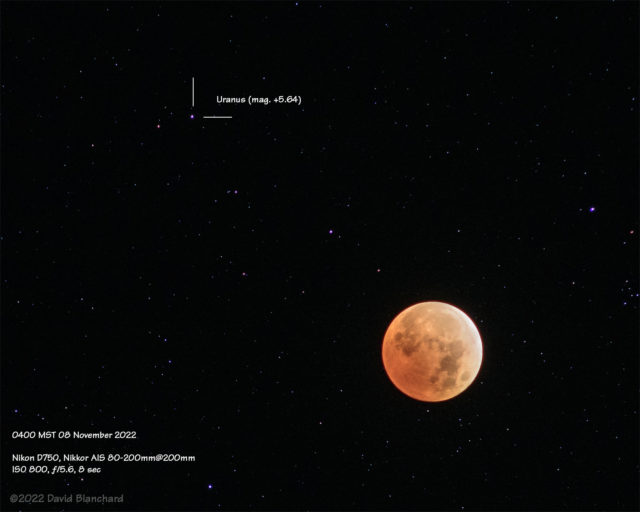
I hope you got to experience the total lunar eclipse that occurred 08 November 2022. I’m really glad we were able to see this since the next total lunar eclipse is not until 14 March 2025. This was also the second total lunar eclipse of the year but that previous one was attended by mostly cloudy skies and we only got a few glimpses of the Moon. This one was so much better!

But it wasn’t entirely certain that we would be able to see the event. There were clouds during the afternoon and evening. When I looked outside at midnight there were bands of high clouds stretching across the sky. But I was more than willing to take a chance and drive to a location in Sedona with very dark skies and warmer temperatures than we had in Flagstaff.
The high clouds continued during the beginning of the partial eclipse (U1) but we could see gaps appearing in the clouds and we ended up with mostly clear skies by the time the Moon was about one half darkened. Totality (U2 through U3) occurred during clear skies and there were only a few patches of high clouds during the final partial stages.
I was using a Nikon D750 and my legacy Nikon 80–200mm ƒ/4 AI-S manual focus lens. It has a hard stop at infinity which makes it very easy to focus in dark conditions. Just rotate the barrel until it stops. Done. It’s also a sharp lens especially when using it at ƒ/8. The camera was mounted on an iOptron Skytracker. This way I could keep the Moon near the middle of the frame and the only motion would be the eastward movement of the Moon against the background of the stars.
The Moon was close in the sky to the planet Uranus making for a more interesting setup. The eclipse last year was near Pleiades—that was really fun to photograph—but it was not quite a total eclipse.
The photograph at the top shows the Moon at various stages from beginning, mid partial, beginning of totality, mid totality, end of totality, mid partial, and the end. The next photograph shows the Moon during maximum totality along with Uranus. And, finally, there is a time-lapse video of the event.
Time lapse of the eclipse.
Previous eclipses discussed on this site: November 2021; May 2022
Finally, pretty much everything you ever wanted to know about eclipses can be found here: https://eclipse.gsfc.nasa.gov/LEcat5/figure.html
Cool!
Thanks!